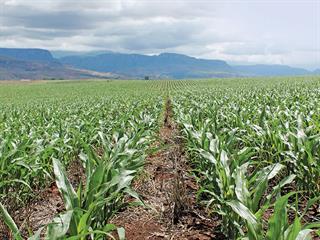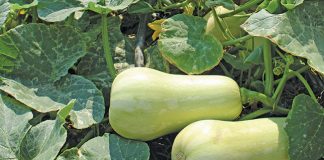
Driving around Bruce Shepherd’s 320ha of dryland yellow maize and soya bean lands, one cannot help noticing how vigorous and strong the young plants are. Despite the intermittent rainfall so far in the 2014/2015 summer grain production season in the Bergville area of KwaZulu-Natal where Bruce farms, the crop looks excellent. A closer inspection of the soil shows why this is so.
The soil surface is covered by the residue of previous crops. Despite the heat of the day, one’s fingers quickly find damp and cool soil underneath the residue layer. A closely examined handful of soil reveals a friable, spongy texture, the result of years of accumulated decomposing organic matter slowly integrating into the soil. Another handful of soil unearths an earthworm, an indicator of truly healthy soil. Under a microscope, it would be no surprise to see this soil teeming with beneficial microbes.
“My late father, Charles, started implementing no-till on East Lynne Farm from the early 1980s,” recalls Bruce. “I joined him in 1995 and became very interested in the no-till concept. I continued implementing it over the years to where the entire 320ha is now under no-till and am still continually looking at ways to make this system work even better.”
Until the winter of 2012, Bruce followed the recognised no-till practice of spraying weeds in recently harvested maize and soya bean lands, and keeping the soils under dead fallow conditions until the following spring. This was to kill weeds while still small and susceptible to herbicide, and to prevent them from seeding. No weeds in a dead fallow land means there are no plants to utilise the precious soil moisture in winter, leaving it for the coming summer grain crop.
With his cropping enterprise being dryland, and the Bergville area receiving around 800mm annually, Bruce works hard at conserving every drop of water.

Bruce Shepherd
“The only soil covering on these dead fallow lands used to be the previous summer’s crop residue,” he says. “I would let cattle graze some of this residue sparingly so as not to defeat its primary purposes of conserving soil moisture, reducing rainfall runoff and soil erosion, improving rainfall infiltration into the soil, integrating organic matter into the soil and providing an environment for beneficial soil microbes.”
A winter cover crop
Then Bruce heard from international and local no-till farmers that planting a winter cover crop on no-till land would benefit soil health and crop yield even more than keeping his lands dead fallow between summer crops. International research showed the many benefits of winter cover crops. Soil microbes feed on plant root exudates. The roots of various plant species produce different exudates and in differing quantities. The greater the plant diversity, the greater the variety of root exudates and the greater the variety of soil microbes supported.
If a soil hosts only a summer grain crop, its roots die after harvest. For the rest of the year and until the summer planting season, very little food is available for the microbes. A cover crop during winter is a bridging food source for these beneficial organisms.
The differing root structures of the various plant species each plays a role in the soil. Tap root systems penetrate deep down into the soil to bring minerals and moisture up the soil profile. When these roots die and decompose, they leave tunnels through which water and air can travel deep into the soil.
Fibrous root systems help bind the soil to give it good structure, reducing soil compaction and minimising erosion. “I was initially wary of trying a cover crop because I was concerned about wasting limited soil moisture reserves during winter,” Bruce recalls. “After all, water is essential for crop yield.”
Trial
But in April 2012, after harvesting the soya bean crop, he allocated a 40ha land to a trial of black and white oats as winter cover crops, establishing white oats on one portion of the land and black oats on another. “I broadcast the seed in late May or early June, using a tractor-mounted fertiliser spreader,” he explains.
“This wasn’t the ideal time, but I did so anyway because I wanted to try growing a cover crop at least once. After broadcasting the seed, I ran a light tractor-drawn disc implement over the land to ensure that the seed would fall out of the residue and onto the soil surface. The very light disc also preserved the structure of soya bean residue.
“As it was, the 2012 winter in our area was uncharacteristically wet and so the oats grew well.” When the trial started seeding in late September and fodder flow was at its lowest, he gave it a light grazing. This benefited the cattle and saved him buying in as much feed as normal to carry the herd into the veld and pasture spring flush. The light grazing left sufficient standing plant material to provide additional residue on the land.
After withdrawing the cattle, Bruce sprayed the land with a glyphosate-based herbicide, planning to plant a yellow maize crop no-till into the residue in mid-November.
“My decision on when to kill off a cover crop depends on many considerations,” he says.
“The first is to conserve soil moisture for the following summer crop. All rain that falls after a cover crop has been killed off becomes available to the following crop. “The second factor is the winter cover crop’s allelopathic effect. Oats has a significant effect on other plant species. If a summer grain crop is planted too soon after oats, the residual allelopathic effects of the oats will affect the grain crop’s germination and growth.”
To investigate this, Bruce once planted yellow maize into a land of glyphosate-sprayed, but still green. oats. Growth and vigour of the maize was patchy and the crop performed poorly. “To avoid this allelopathic effect, I now plant the maize or soya beans at least two weeks after I’ve killed off the cover crop,” he says. “But I prioritise soil moisture availability for the summer crop, so ideally kill off the cover crop about two months before planting the summer crop.”
Variety
During the winters of 2012 to 2014, Bruce started experimenting with different cover crops. He had read that varying the winter cover crop increased its effectiveness still further.
“Different cover crops have different root systems,” he says. “They also differ in growth period, physical characteristics and even tolerance to environmental conditions. Planting only a water stress-tolerant species that can’t tolerate cold temperatures will defeat the benefit of a cover crop if it dies after the first frost. Some cover crops are good at accessing free soil nutrients such as nitrogen and making them available to the following summer crop. This is why I’m now working on finding the ideal cover crop mixture for my no-till system.”
With limited experience in multi-species cover crops, Bruce consulted local dairy farmers for ideas on which species to try on his farm. In 2014, he settled on a mixture of white Drakensberg oats, black oats, bunch rye, Persian clover, rape, purple top turnip, canola, mustard and Japanese radish. Included in this seed mix was snail bait to kill off any snails in the young plants.
“I established this seed mix into standing maize on 12 March,” he recalls.
“The maize was already drying off and no longer needed soil moisture. I also wanted to give the cover crops the benefit of late summer rainfall for a good start. As the maize was still standing, I contracted a fixed-wing crop sprayer to air-seed the cover crop seed mixture into the maize and soya bean crops in late March/early April when the crops were starting to dry off. I didn’t want the cover crop to be too tall when I harvested the soya beans to avoid the cover crop interfering with the harvesting.”
Cutting costs
For the coming winter, Bruce is considering planting cover crops into the soya bean crop using a tractor-drawn seed spreader or a seed drill to save on planting costs and improve germination. Applying the seed from the ground will improve seed-to-soil contact, a crucial factor. A potential problem is that planting can only take place three or so weeks later than with air-seeding as the soya bean crop must first be harvested.
His machinery and workers will also be committed to harvesting maize and soya beans, before the cover crop can be planted into the soya bean residue. However, the cover crops will still be air-seeded into the standing maize.“At this stage, I don’t want to reveal my cover crop seed mixture ratio as it’s still experimental,” he says.
“Other farmers considering a multi-species cover crop mixture must adapt the ratio and species to their own conditions. My mixture costs between R400/ha and R500/ha, excluding air-seeding costs. I also haven’t yet quantified all the benefits my no-till cropping has gained from including a winter cover crop. However, international research confirms the benefits are there.”
Bruce admits that a winter cover crop adds to his total production cost, but it is worth it.
“Benefits such as improved growth and yield in the summer crop, the value added to late winter forage for my cattle and the increased sustainability of the soil more than compensate for this. Even if I get only a ton of additional fodder per hectare, valued at a conservative R1 000/t, from the cover crop, I’ve already covered more than its production cost.”
Phone the No-Till Club on 033 330 2062 or visit www.notillclub.com.
Visit www.sare.org and search for “Managing Cover Crops Profitably” to download a guide that Bruce Shepherd consults.












